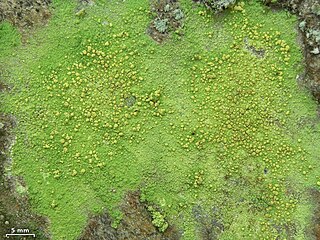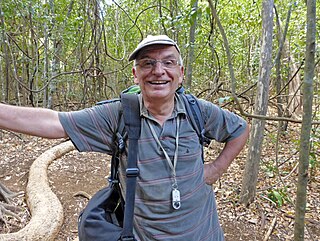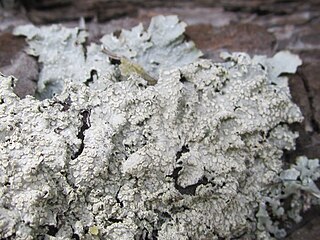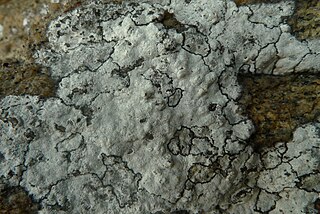
Ascomycota is a phylum of the kingdom Fungi that, together with the Basidiomycota, forms the subkingdom Dikarya. Its members are commonly known as the sac fungi or ascomycetes. It is the largest phylum of Fungi, with over 64,000 species. The defining feature of this fungal group is the "ascus", a microscopic sexual structure in which nonmotile spores, called ascospores, are formed. However, some species of the Ascomycota are asexual, meaning that they do not have a sexual cycle and thus do not form asci or ascospores. Familiar examples of sac fungi include morels, truffles, brewer's yeast and baker's yeast, dead man's fingers, and cup fungi. The fungal symbionts in the majority of lichens such as Cladonia belong to the Ascomycota.

The Cladoniaceae are a family of lichenized fungi in the order Lecanorales. It is one of the largest families of lichen-forming fungi, with about 560 species distributed amongst 17 genera. The reindeer moss and cup lichens (Cladonia) belong to this family. The latter genus, which comprises about 500 species, forms a major part of the diet of large mammals in taiga and tundra ecosystems. Many Cladoniaceae lichens grow on soil, but other can use decaying wood, tree trunks, and, in a few instances, rocks as their substrate. They grow in places with high humidity, and cannot tolerate aridity.

The Parmeliaceae is a large and diverse family of Lecanoromycetes. With over 2700 species in 71 genera, it is the largest family of lichen-forming fungi. The most speciose genera in the family are the well-known groups: Xanthoparmelia, Usnea, Parmotrema, and Hypotrachyna.
Kantvilasia is a lichen genus in the family Pilocarpaceae. This is a monotypic genus, containing the single species Kantvilasia hians.

Psilolechia is a genus of four species of crustose lichens. It is the only member of Psilolechiaceae, a family that was created in 2014 to contain this genus.

Lecanactis is a genus of crustose lichens, commonly called old wood rimmed lichen. The genus was circumscribed in 1855 by German lichenologist Gustav Wilhelm Körber, who assigned Lecanactis abietina as the type species.

Lepidostromatales is an order of fungi in the class Agaricomycetes. It is the only known order of basidiomycete fungi composed entirely of lichenized members. Morphologically, the fruiting bodies of all species are clavarioid. Six species are known, five of which were described within the span of 2007–2013. Due to its morphological similarity to the genus Multiclavula, its isolated phylogenetic position was not understood until quite recently. The photobionts that have been found in association with members of this group are not known to associate with any other types of lichenized fungi.
Little work has been done on the lichens of Madagascar, so while over 500 species of lichens have been documented, more are expected. Madagascar can be divided into two major habitats that can be associated with lichen distribution. Wet tropical areas of siliceous bedrock make up approximately two-thirds of the country, and are where most of the lichens have been documented. Dry tropical areas of granitic and limestone bedrock make up the other one-third of the country with just over 20 species documented in these habitats. The following table lists the species known from the dry tropical habitats. The majority are corticolous species that grow on the bark of trees or shrubs. A few are saxicolous; species that grow on rocks. The full list of 500 lichens can be found at.
Parmotrema abessinicum is a species of corticolous lichen in the family Parmeliaceae. It has been recorded from Africa, Asia, and Oceania.

Malmideaceae is a family of crustose and corticolous lichens in the order Lecanorales. It contains seven genera and about 70 species.

Malmidea is a genus of crustose lichens and the type genus of the family Malmideaceae. It was established in 2011 to contain a phylogenetically distinct group of species formerly placed in the genus Malcolmiella. Malmidea comprises more than 50 mostly tropical species that grow on bark, although a few grow on leaves.
Alan W. Archer is a mycologist. He is currently an honorary research associate at Royal Botanic Gardens Sydney, and working on the chemotaxonomy of the lichen genus Pertusaria together with a key to all taxa in that genus.

Emmanuël Sérusiaux is a Belgian lichenologist. His career, spanning more than four decades, has combined both lichenology research and political aspects of nature conservation. He spent several periods working as a researcher at the National Fund for Scientific Research and the University of Liège, the latter in which he accepted a faculty position as professor and head of the Plant Taxonomy and Conservation Biology unit. Sérusiaux also served for three non-consecutive appointments as Deputy Chief of Staff in the Government of Wallonia. He retired from both his academic and political positions in 2019.

Opegraphaceae is a family of lichen-forming and lichenicolous fungi in the order Arthoniales. It was originally proposed by German lichenologist Ernst Stizenberger in 1862. It fell into disuse, but was resurrected in a molecular phylogenetic study of the order Arthoniales published in 2010. It now includes taxa that were previously referred to the family Roccellaceae, its sister group.

Impatiens serusiauxii is a species of flowering plant in the family Balsaminaceae. Native to Madagascar, it was formally described as a new species in 2020 by Eberhard Fischer, Elisette Rahelivololona, and Dorothee Killmann. The specific epithet honours the Belgian lichenologist Emmanuël Sérusiaux, who accompanied Fischer on a collecting trip where the type was collected. The plant is known only from Mt. Marojejy, where it grows in sclerophyllous cloud forest and ericaceous shrub at elevations of 1,200 to 1,500 m. It was previously mistaken for Impatiens manaharensis, which differs slightly in morphology such as leaf shape, and flower colour and structure.
Pseudopyrenula serusiauxii is a species of lichen-forming fungus in the family Trypetheliaceae. It is found in Papua New Guinea. The lichen appears as a greenish discolouration on the trunks of Macaranga trees.
Punctelia colombiana is a species of foliose lichen in the family Parmeliaceae. It is found in South America.
Taeniolella serusiauxii is a species of lichenicolous fungus in the family Mytilinidiaceae. It was described as a new species in 1992 by Paul Diederich. The type was collected in France, where it was found growing on Dendrographa decolorans. The specific epithet serusiauxii honours the Belgian lichenologist Emmanuël Sérusiaux.

Punctelia perreticulata is a widely distributed species of foliose lichen in the family Parmeliaceae. It occurs in Mediterranean Europe and Russia, North America, South America, Australia, and New Zealand, where it grows on rocks, bark, or wood. Its main distinguishing features are its thallus surface, marked with many shallow depressions, grooves, or pits, and sorediate pseudocyphellae. The lower side of the thallus is ivory to tan towards the centre and the major secondary metabolite in the medulla is lecanoric acid. A lookalike species with which it has been historically confused is Punctelia subrudecta; this lichen can be distinguished from Punctelia perreticulata by the texture of the thallus surface, or, more reliably, by the length of its conidia.

Roccellographaceae is a family of lichen-forming fungi in the order Arthoniales. It contains three genera: Dimidiographa, Fulvophyton, and Roccellographa.











